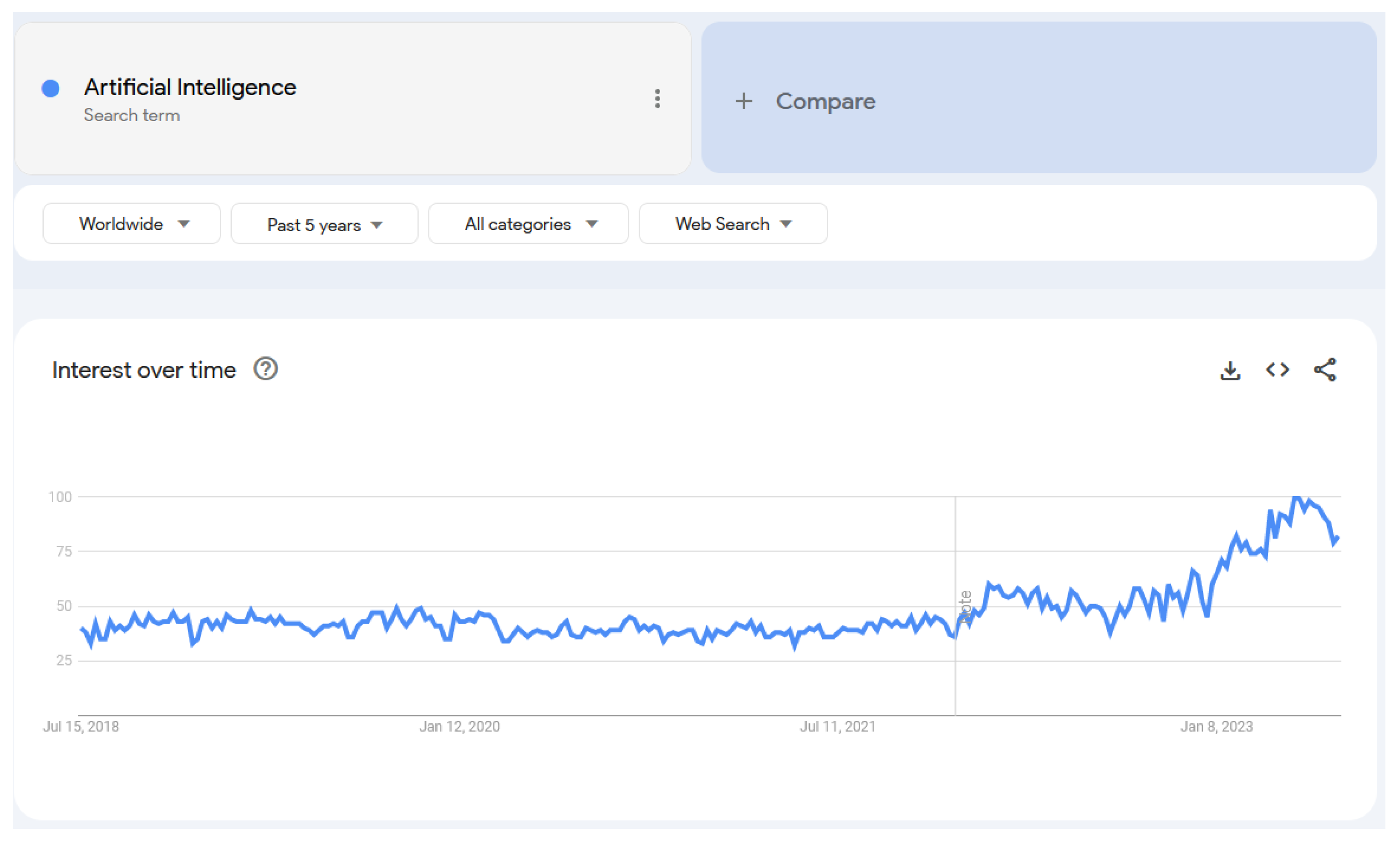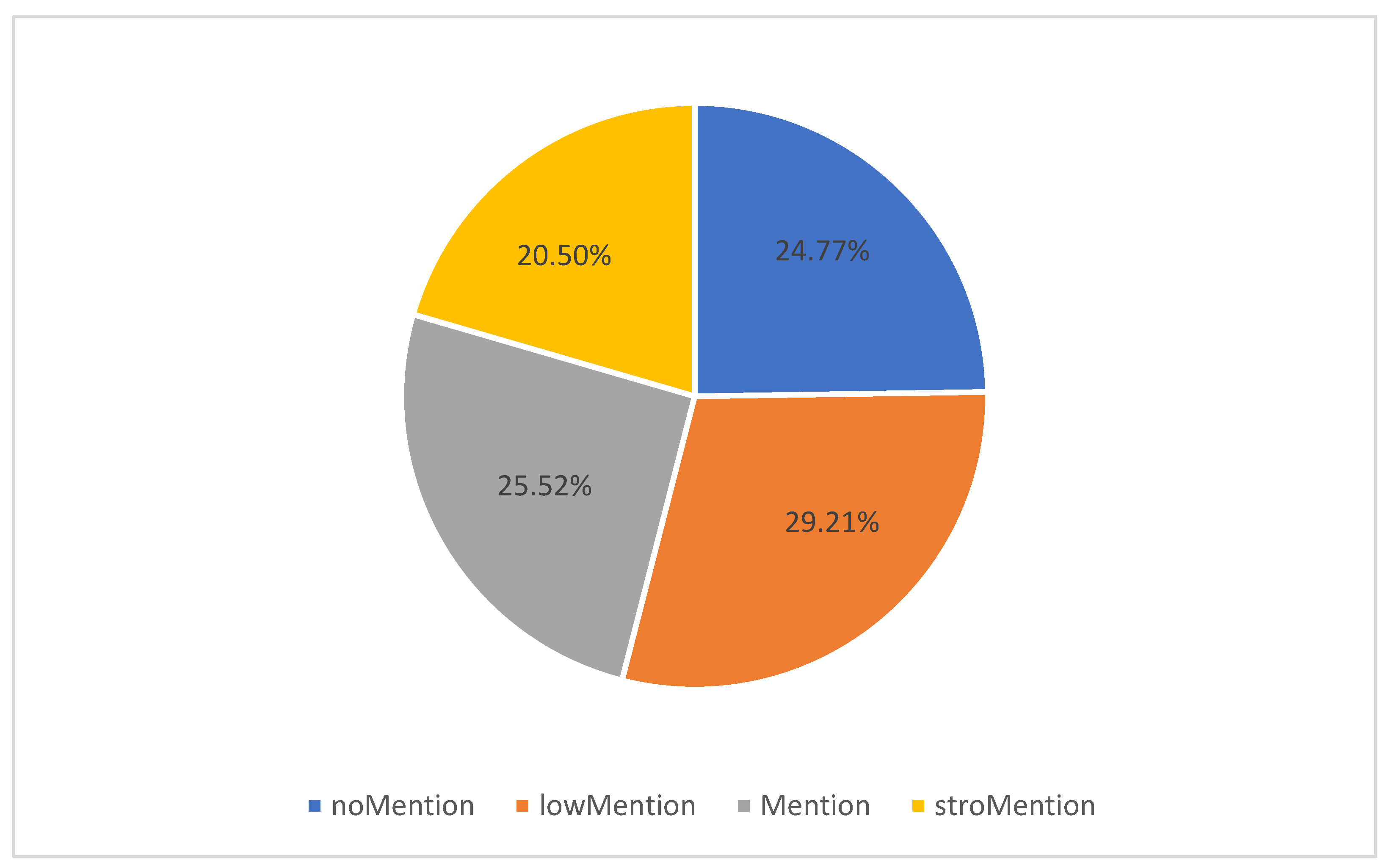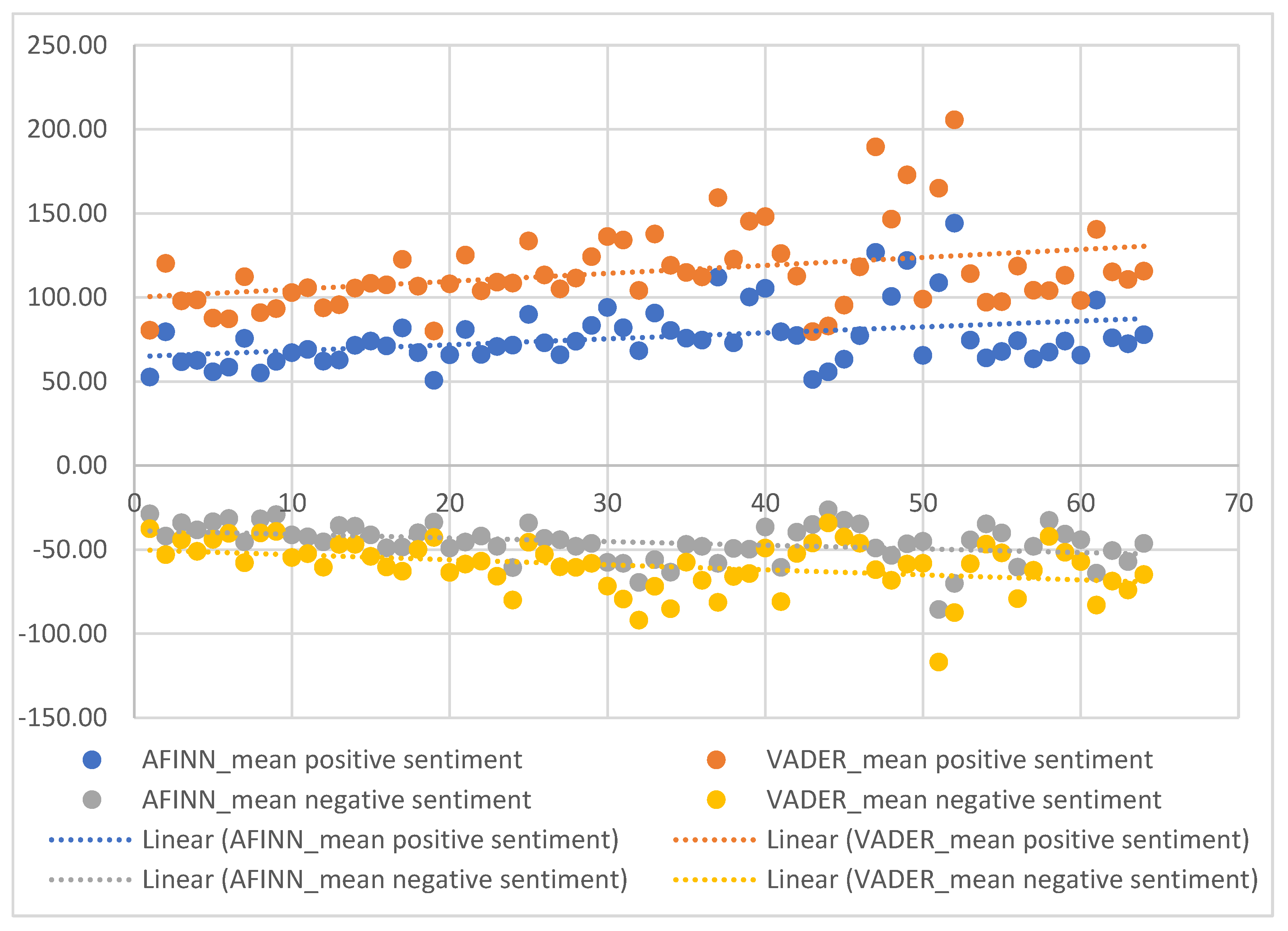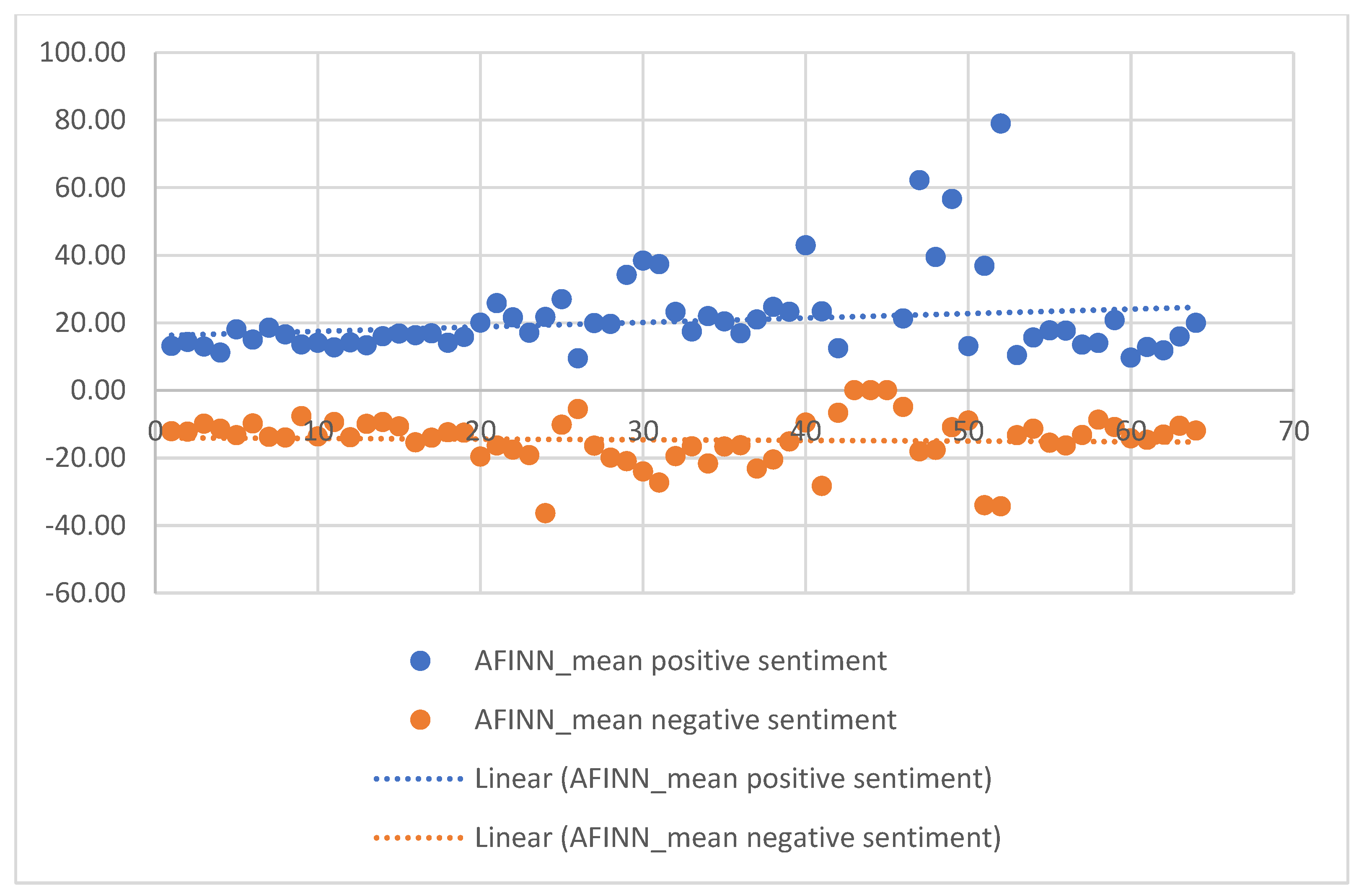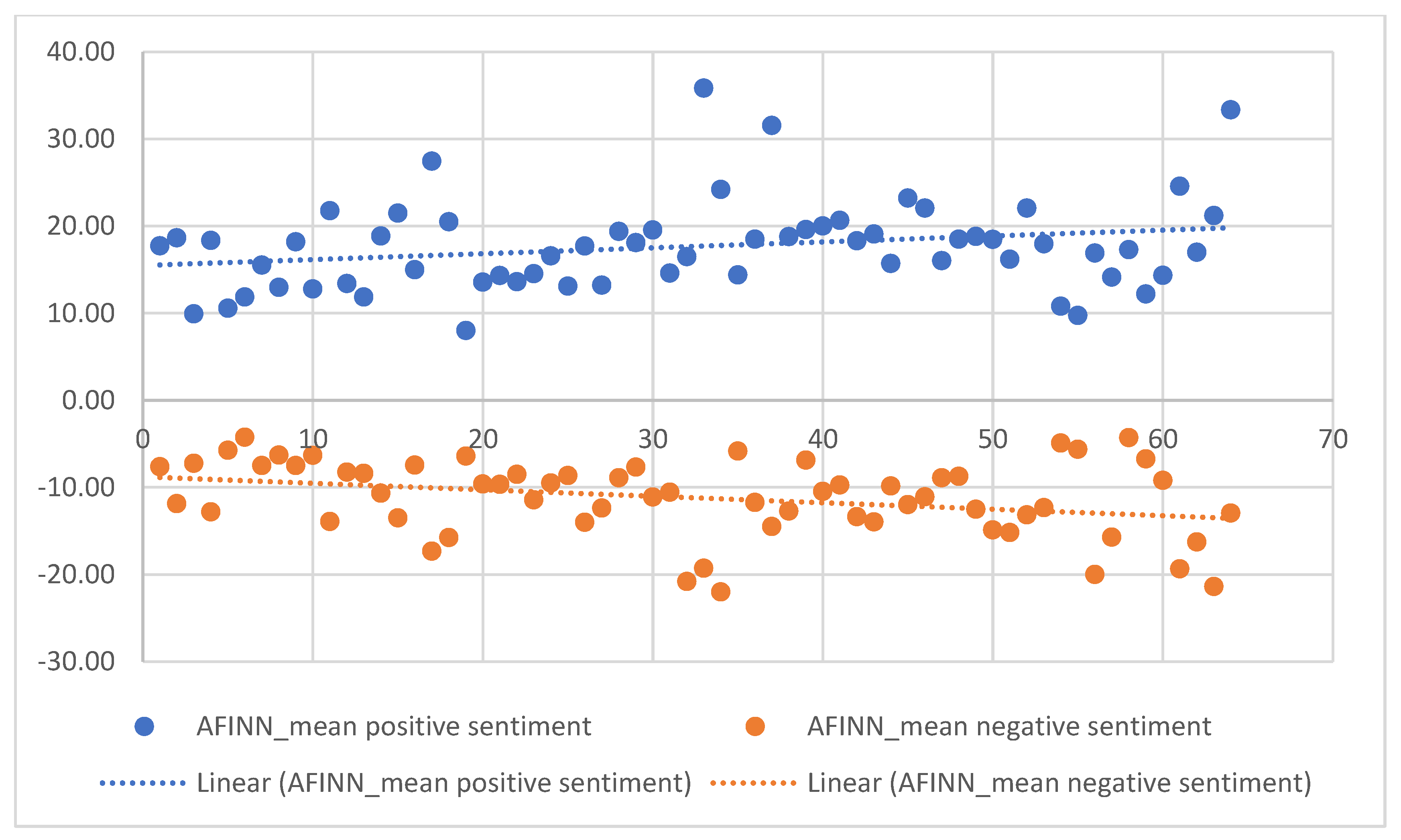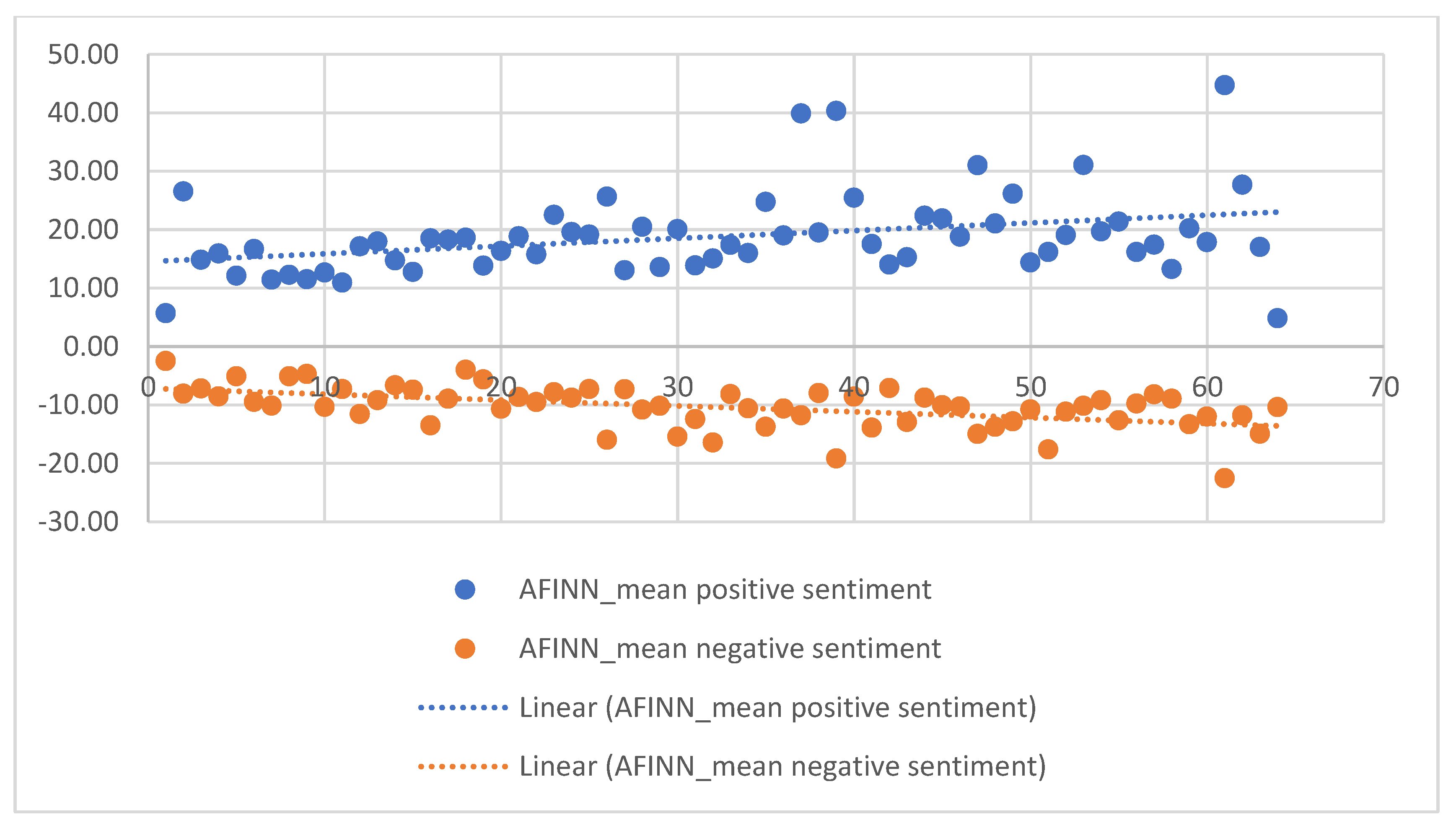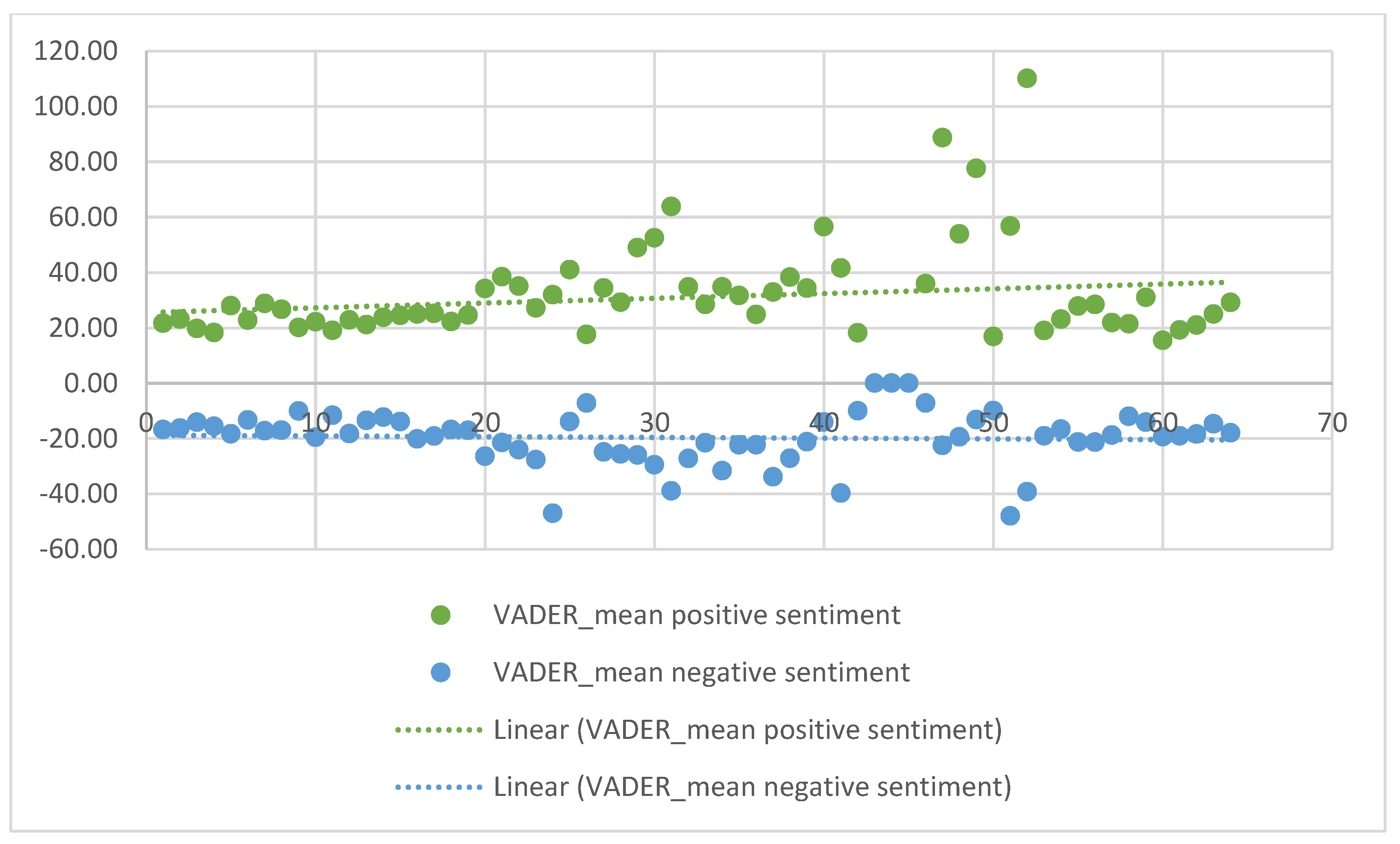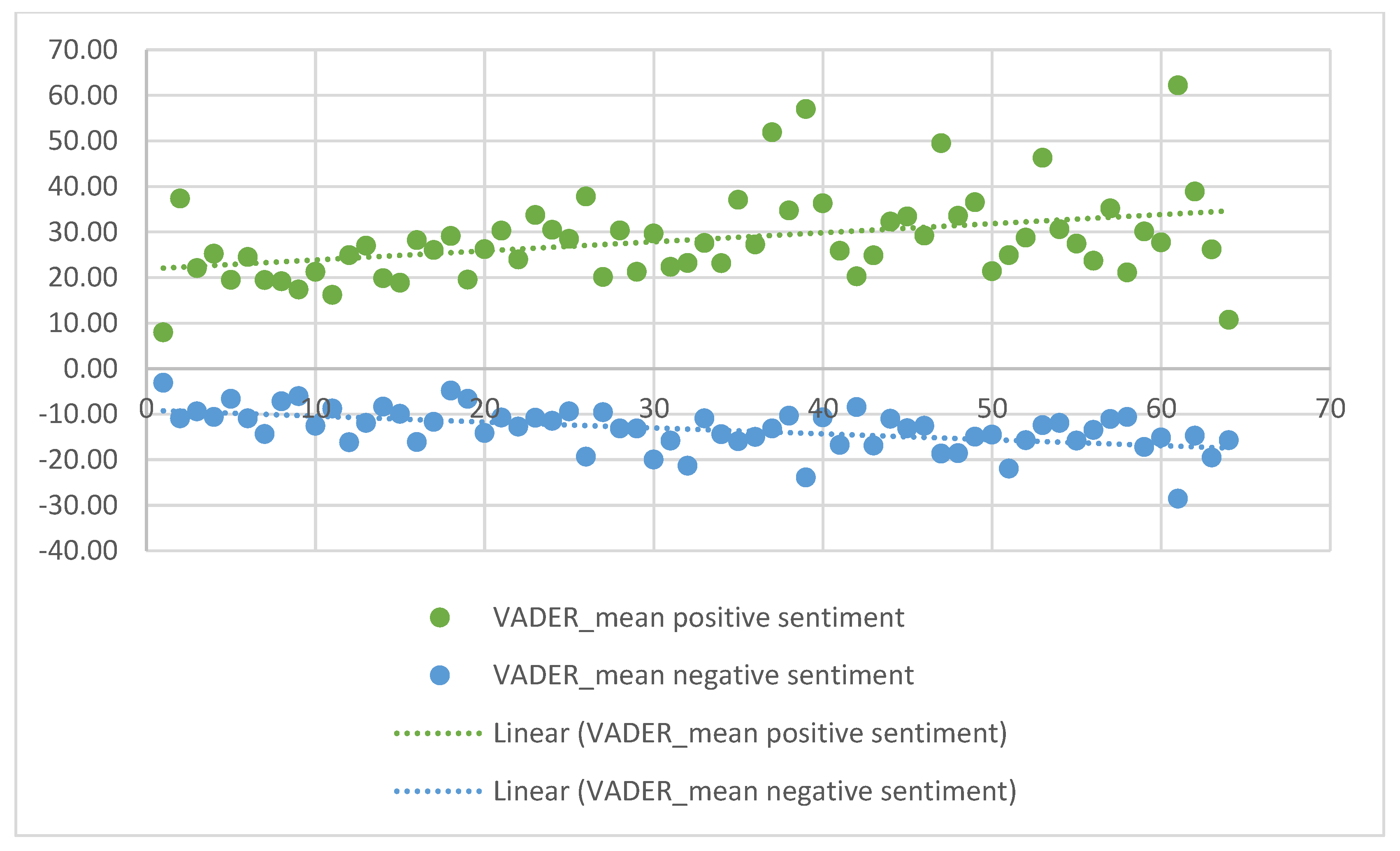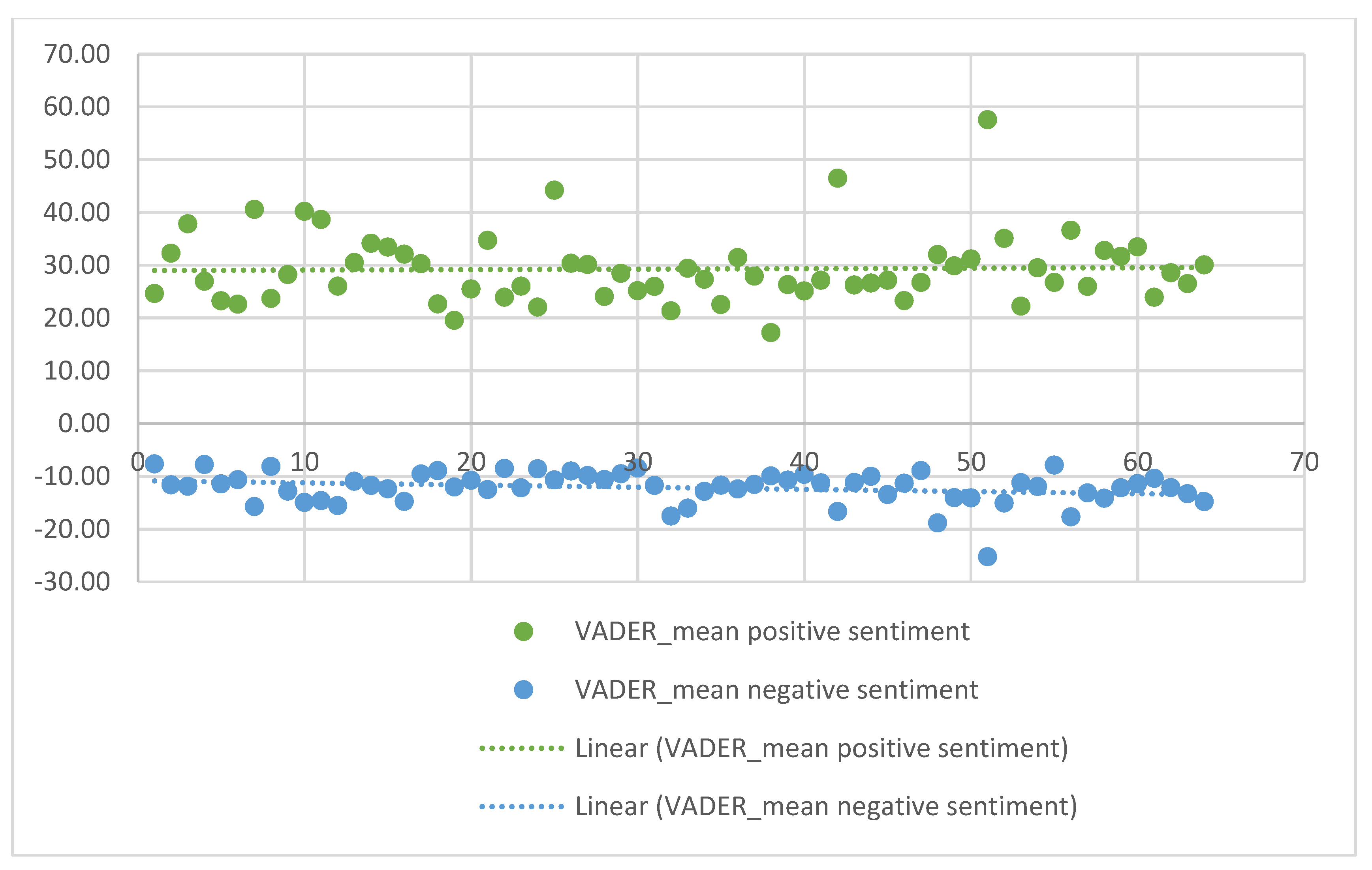1. Introduction
Artificial intelligence (AI) has made outstanding progress in recent years [
1,
2,
3,
4]. Although its potential benefits are recognized, there are also concerns being raised about its impact on society, economy, and ethics since it is assuming a vital role in shaping culture, exerting an ever-growing influence on actions and decisions [
5,
6,
7,
8,
9,
10]. As a result of its increasing presence and significance in various fields, including technology, business, and research [
11], AI has garnered widespread attention and discussion in academic fields but also news media and popular culture, as is evident when checking
Google Trends, as shown in
Figure 1 [
12,
13].
Its portrayal in the media influences how people recognize its capabilities, benefits, risks, and ethical implications, and therefore, it plays a crucial role in shaping public perception [
14]. Understanding how AI is presented in the media helps in assessing the accuracy, bias, and overall impact on public opinion and, therefore, can aid the development of effective strategies for promoting critical and conscious attitudes, enhancing the public’s knowledge and awareness of AI technology. This study aimed to examine the tone and framing of articles related to the topic of AI by analyzing online articles from
WIRED magazine during the last five years and compare this with survey data reflecting public opinion on AI. The objective was to identify trends in media coverage that could influence public perception of AI and to take the first step towards understanding whether media representations of AI influence or reflect public attitudes. Specifically, the media coverage trends were obtained through the text mining of
WIRED articles, while the perception of the general public was obtained through a literature review of studies on public perception as a first approach to the topic. This research could provide insights into the evolving attitudes of specialized news media toward AI and the potential influence of media in shaping public comprehension and perceptions of such emerging technologies.
Among thousands of magazines on the web ranked by traffic and social media followers [
15],
WIRED magazine—a monthly American magazine that focuses on emerging technologies and their relationship with culture, economy, and politics—is considered the most influential source of technological information for a wide and differing range of people. The increasing significance of artificial intelligence (AI) in today’s society, as evidenced by its consistent coverage in media outlets such as
WIRED magazine, underscores the importance of understanding public sentiment towards this transformative technology. The study conducted in this work, focused on
WIRED magazine’s coverage from January 2018 to April 2023, offers a comprehensive glimpse into the evolving narrative surrounding AI. The analysis revealed a clear trend over time in the sentiments expressed in AI-related articles. On the one hand, positive sentiment showed a notable increase, indicating a growing optimism and favorable views towards AI. On the other hand, negative sentiment also exhibited an upward trend, indicating an intensification of concerns and criticisms related to AI. The dynamic of sentiments reflects the evolving perceptions and attitudes towards AI, highlighting the importance of monitoring and understanding the shifting landscape surrounding this technology and providing and contributing to existing research on the media’s depiction of AI and the public’s perception of AI [
16,
17,
18,
19,
20,
21,
22,
23,
24,
25,
26].
2. Artificial Intelligence and Society
The fast evolution of artificial intelligence in society depends on several factors; one is the simultaneous accessibility of powerful and cost-effective computing and of large datasets, and another is the speed of industry, which has raced ahead of academia. Until 2014, the most substantial machine learning models were announced by academia. Since then, industry has taken over [
5].
A recent study suggests that Chinese citizens feel more positively about AI products than Americans and that men tend to feel more positively about AI products and services than women [
12].
In fact, artificial intelligence has wide-reaching potential for society in different scenarios, especially when speaking about health, finance, information technology, education, transportation, and environmental monitoring.
In the realm of health, AI applications range from diagnostic tools and personalized medicine to predictive analytics that can help identify disease outbreaks and optimize healthcare resource allocation. The integration of AI technologies in healthcare systems has the potential to enhance patient outcomes, streamline processes, and contribute to the development of innovative treatments, self-monitoring, and coaching, for example. Furthermore, AI is expected to improve the quality of care and health of patients by decreasing human errors [
27].
In the finance sector, AI plays a crucial role in risk management, fraud detection, and algorithmic trading [
28].
The information technology (IT) landscape is continually evolving with AI-driven advancements. In IT, AI-driven advancements have led to transformative developments across various domains. Examples include the implementation of natural language processing (NLP) for improved human–computer interactions [
29], the use of machine learning in cybersecurity for proactive threat detection [
30], and the application of predictive analytics to anticipate and prevent system failures. Automated code generation and testing, personalized user experiences, and autonomous IT operations are other notable areas where AI enhances efficiency [
31]. Additionally, AI contributes to data management and analysis, image and speech recognition, and robotic process automation in IT processes [
32]. These advancements collectively optimize workflows, improve security, and elevate the overall user experience in diverse IT applications.
In the field of education, AI applications include personalized learning platforms, intelligent tutoring systems, and educational analytics. Analyzing sentiment in media coverage can reveal societal attitudes toward AI in education, helping institutions tailor their strategies to meet the evolving needs of students, educators, and the workforce [
33].
The impact of AI on transportation is transformative, with applications ranging from autonomous vehicles and traffic management to predictive maintenance [
34]. Understanding public sentiment through media analysis is crucial for policymakers and transportation authorities to address concerns related to safety, privacy, and the integration of AI-driven technologies in urban planning.
Lastly, in environmental monitoring, AI-powered technologies assist in data analysis, climate modeling, and conservation efforts [
35]. Analyzing sentiment in media coverage can shed light on public attitudes toward AI’s role in addressing environmental challenges, helping shape policies that balance technological progress with ecological sustainability.
In conclusion, sentiment analysis regarding media coverage of AI is a powerful tool for understanding societal expectations, concerns, and perceptions. This knowledge is instrumental in steering the development and deployment of AI technologies toward responsible, ethical, and beneficial outcomes for society.
3. AI Publications
The global landscape of English-language and Chinese-language AI publications has experienced substantial growth over the past decade [
12]. Specifically, the quantity of computer science papers published and categorized under the keyword “artificial intelligence” in the Scopus database of annual academic papers rose by over ninefold from 1996 to 2017. While the number of papers within the general field of computer science has grown by six times since 1996, the number of AI papers produced each year has increased by more than nine times in that same period [
36]. Europe consistently holds the position as the leading contributor to AI papers, with 28% of AI papers on Scopus originating from Europe in 2017. The number of papers published in China has experienced a notable increase, witnessing a 150% increase between 2007 and 2017. In 2017, a substantial 56% of papers were categorized under “machine learning” and “probabilistic reasoning”, marking a significant rise from 28% in 2010. Notably, across most categories, the publication rate accelerated from 2014 to 2017 compared to the period between 2010 and 2014 [
37]. Between 2010 and 2021, there was a remarkable surge, with the total number of AI publications more than doubling. Specifically, the count increased from 200,000 in 2010 to nearly 500,000 by 2021 [
12].
Concerning AI journal publications, in 2020, they exhibited a remarkable increase, standing at 5.4 times the count recorded in 2000, with a substantial increase of 34.5% from the preceding year. Additionally, the proportion of AI journal publications relative to the total global publications witnessed a significant uptick in 2020, marking an increase of 0.4 percentage points [
9].
Regarding AI conference publications, there was a peak in 2019, followed by a decline of approximately 19.4% below the peak in 2021, which may be mainly due to the COVID pandemic since face-to-face conferences were significantly reduced in this period. Even with this decrease in total numbers, the proportion of AI conference publications in relation to the overall global conference publications has risen by over five percentage points since 2010 [
10].
Several specific topics stand out as dominant focal points, influencing the direction of advancements in the field. These include pattern recognition, machine learning, and computer vision. This substantial increase underscores the interest, research, and dissemination of knowledge in the field of artificial intelligence, reflecting a dynamic and expanding scenery of contributions to the scientific and technological discourse worldwide.
In 2021, most published AI documents, constituting 60%, were in the form of journal articles, followed by 17% as conference papers and 13% as repository submissions. The remaining 10% comprised books, book chapters, theses, and other document types. Notably, journal and repository publications have seen significant growth, expanding by 3 times and 26.6 times as much, respectively, over the past 12 years. In contrast, the number of conference papers has experienced a decline since 2019 [
36].
Examining the distribution of publications in the AI field across sectors revealed a clear dominance of the education sector, accounting for nearly 70% of the total. Following closely are nonprofit organizations, industry-related publications, and government contributions [
10].
Following a period of modest growth between 2010 and 2015, the landscape of AI journal publications has witnessed a notable surge, expanding approximately 2.3 times since 2015. Notably, the momentum of this growth accelerated further in the recent span of time from 2020 to 2021, with a remarkable increase of 14.8%. This surge reflects heightened interest and commitment within the academic and research communities to contribute to the evolving field of artificial intelligence, signifying a dynamic phase of expansion and innovation [
37].
The increased rate of AI journal publications suggests a growing emphasis on disseminating research findings and insights within the academic sphere. This trend aligns with the recognition of AI as a rapidly advancing field, with researchers and scholars keen to share their discoveries, methodologies, and advancements to contribute to the collective knowledge base [
12].
The substantial uptick in publications from 2020 to 2021 indicates a heightened pace of scholarly activity and research output, potentially driven by the increasing relevance of AI applications, emerging technologies, and the evolving challenges within the field. This surge in AI journal publications not only underscores the dynamic nature of AI research, reflecting the continuous evolution and expansion of knowledge within the field, but it also emphasizes the urgent need to explore public perceptions of artificial intelligence. As AI becomes increasingly integrated into various aspects of society, understanding how the public perceives and responds to these advancements is fundamental.
4. A Study of WIRED Magazine
4.1. Materials
The initiation of the study involved a meticulous process of selecting a news source that held particular significance for the research. This crucial step necessitated the exploration and assessment of various online sources, with careful consideration given to factors such as relevance, credibility, and coverage breadth. Several platforms were examined and accessed to ensure that the chosen news source would provide a comprehensive and meaningful dataset for the study. As the study aimed to explore attitudes toward AI in popular culture, an initial selection of the top 10 technology magazines, known for their influential status, was identified based on web traffic and social media following. These include
WIRED,
Computer World,
MIT Technology Review,
E&T Magazine,
Tech Advisor,
Digit Magazine,
Tech Briefs,
Innovation & Tech Today,
Trotons Tech Magazine, and
MDPI Technologies, as listed by a media contact database [
37,
38].
However, WIRED magazine stands out, displaying web traffic and a social media following an order of magnitude greater than its counterparts. Focusing the analysis on WIRED allows for uniformity in reporting style and depth, offering a coherent narrative on AI’s portrayal in a leading technology publication. This approach positions WIRED as a case study for potential future research extending to other publications, ranging from popular to academic.
This methodical approach aimed to establish a robust foundation for the research by aligning it with a news outlet that not only reflected the contemporary discourse on the subject but also ensured the availability of diverse and pertinent information for a thorough analysis. The online magazine
WIRED was chosen as the focus of this study for several reasons. Firstly, it is widely recognized as a reputable and influential publication in the field of technology and innovation [
15]. According to their press center, WIRED reaches more than 30 million people each month through its website [
39]. It has a dedicated readership consisting of technology enthusiasts, professionals, and industry experts who actively engage with the magazine’s content [
15]. Secondly,
WIRED magazine has consistently covered topics related to artificial intelligence (AI) over the years, making it a valuable source of information and insights on the subject. The magazine’s coverage often includes in-depth articles, opinion pieces, and analysis, which provide a comprehensive view of the prevailing opinions and perspectives towards AI. Furthermore,
WIRED magazine’s readership and content reflect a diverse range of perspectives and opinions within the technology and AI communities [
15].
By analyzing articles from WIRED magazine, this study aimed to capture a broad spectrum of opinions and attitudes towards AI, enhancing the overall understanding of the prevailing sentiments and public perception in this specific context. Lastly, the availability and accessibility of WIRED magazine’s archives and digital resources make it a practical and convenient choice for conducting such a study. The ability to analyze a substantial number of articles provides robust and reliable data for research. Using the search query tag “artificial intelligence”, 4265 articles were retrieved for this work from WIRED magazine over the period between January 2018 and April 2023. The term “artificial intelligence” is a specific and widely recognized term that directly corresponds to the primary subject of study. For this reason, “artificial intelligence” was chosen as the keyword for conducting the search in WIRED’s database. It ensured that the articles retrieved were predominantly pertinent to the AI discourse, enabling a broad and in-depth examination of the various discussions, perspectives, and advancements associated with AI. Therefore, this approach provides a comprehensive overview of how the technology is portrayed in the media. However, a potential limitation includes the possibility of encountering articles that only peripherally reference AI. For this reason, a word frequency analysis by calculating the occurrences of the terms “artificial intelligence” and “AI” in each article was performed in order to assess the level of discussion within each article and to classify the articles based on the extent to which they referenced the topic. Another possible limitation could be to overlook specific subdomains of AI technology such as machine learning, neural networks, or autonomous vehicles. Nonetheless, since journalists typically tag articles to reflect their core content, the search is likely to encompass a range of AI-related topics, including specific technologies and applications. The chosen timeframe, from January 2018 to April 2023, strategically encompasses both the nascent and more recent stages of AI development, allowing for a thorough analysis of evolving trends and shifts in public discourse regarding AI. This period also helps in understanding how the definition and scope of “artificial intelligence” may have shifted, and the study can track and analyze how these changes impact media portrayal and public understanding.
4.2. Methods
Considering these factors, selecting
WIRED magazine as the primary source for this study enables a focused examination of opinions towards AI. In particular, we analyzed 4265 articles related to the topic of AI from the website of
WIRED magazine between January 2018 and April 2023 [
40].
Content and sentiment analysis in news media often entails the manual classification of articles [
17,
41]. However, given the objective of this work to evaluate sentiments across a 5-year span and with a large number of articles, traditional manual approaches proved inefficient due to their low throughput, rendering them unsuitable for this extensive study. Consequently, an automated approach was considered for this work, leveraging a high-throughput methodology that utilizes coding and automated analysis.
To analyze the unstructured text data, the R programming language [
42] was utilized, and its associated packages were used for text mining and sentiment analysis [
43]. Various methods including AFINN, VADER, SentiWordNet, SentiStrength, and the Liu and Hu opinion lexicon were considered for performing sentiment analysis. The two lexicons demonstrating the highest performance in previous research [
44], specifically AFINN [
45] and VADER [
46], were selected. The selection of two techniques and the identification of those with the best performance were executed to ensure the validity and reliability of the analysis conducted in this work and to maintain consistency throughout the study. This automated process allows the authors of this work to conduct sentiment analysis on a larger number of AI news articles, essentially treating them as big data, surpassing the practical limits of manual checking. The paper by Al-Shabi (2020) discusses the limitations and biases of VADER and AFINN sentiment analysis tools. Both methodologies potentially overlook the nuances of irony, sarcasm, and double meanings. AFINN offers a direct approach to measuring sentiment but fails to consider the context, whereas VADER, despite its content awareness, adheres to rigid thresholds for sentiment classification and struggles with texts exhibiting mixed emotions. It is important to note, however, that news articles, the focus of this study, typically employ more direct language to avoid confusing the audience and to fulfill their primary objective of informing. This factor somewhat mitigates the first issue of these techniques not capturing the subtle and evolving nature of language. To address the second limitation, the decision was made to employ both techniques rather than relying on a single one, aiming for a more robust and comprehensive analysis.
The text of articles was prepared for analysis; text data were converted into tidy format and tokenized. Tidy format is a way to organize data popularized by Hadley Wickham [
47]. Tokenization is the procedure of splitting a given text into units called tokens. AFINN assigns scores to tokens, ranging from −5 (very negative) to +5 (very positive). The overall sentiment of a text is determined by summing the scores of individual tokens. This method does not consider sentence context but is straightforward and effective for certain applications. VADER (Valence Aware Dictionary and sEntiment Reasoner) assigns scores to tokens ranging from −4 (extremely negative) to +4 (extremely positive). VADER not only scores words but also takes into account the context of a sentence, including punctuation, capitalization, and modifiers, to better understand the sentiment. VADER is particularly good at handling texts with mixed sentiments and is capable of identifying the intensity of sentiment in a given text. The scale ranges of [−4, +4] and [−5, +5] were adjusted to a unified scale of [−1, +1] to facilitate the comparison between the AFINN and VADER sentiment analysis techniques, ensuring consistency in the measurement metrics across both methods.
Furthermore, in this research, topic modeling—a technique for identifying different topics within a text corpus, where each document is viewed as a blend of these topics—was not utilized. This decision was made because the texts in the dataset are seen as conveying a wider narrative about AI. Consequently, the analysis conducted in this work does not depend on examining isolated tokens, focusing instead on the broader thematic content.
Figure 2 shows an example of the output of the sentiment analysis with both techniques.
A “positive score” and a “negative score” were calculated for each article using both techniques. The “positive score” represented the sum of all scores that contributed positively, and the “negative score” represented the sum of all scores that contributed negatively. An “Overall score” was then computed as the algebraic sum between the “positive” and “negative scores”. Based on the “overall score”, articles were classified as “positive”, “negative”, or “neutral” if the overall score was either positive, negative, or equal to zero. Moreover, a linear regression analysis was conducted for mean positive and negative scores for each month obtained from both AFINN and VADER techniques. This analysis aimed to provide a better understanding of how the sentiments concerning AI have evolved over time.
Finally, a word frequency analysis on the articles was performed. This analysis aimed to evaluate the extent to which articles discussed the topic of artificial intelligence by counting the frequency of the terms “artificial intelligence” and “AI” in each article. Based on this, the articles were categorized according to the varying degrees to which the topic was mentioned.
5. Results
The analysis conducted in this work revealed that 25% of the analyzed articles did not mention the terms “artificial intelligence” or “AI”, 29% of the analyzed articles mentioned the terms “artificial intelligence” or “AI” only once, 25% of the analyzed articles mentioned the terms “artificial intelligence” or “AI” two to four times, and 20% of the analyzed articles mentioned the terms “artificial intelligence” or “AI” more than four times. Therefore, articles were categorized into four categories: “NoMention”, “lowMention”, “Mention”, and “stroMention” (see
Figure 3).
The categorization enabled the authors of this work to investigate the different levels at which the topic of artificial intelligence was discussed in the analyzed articles and to better understand the trends in
WIRED magazine’s coverage of this topic. The first result of the analysis of the articles was that nearly half of the articles that were tagged with the keyword “artificial intelligence” did not explicitly mention it. This observation could be attributed to the possibility of an overuse of the tags “artificial intelligence” or a need for
WIRED magazine to use more context-specific terminologies, depending on the article’s content. This result raises questions about the accuracy and relevance of using the term “artificial intelligence” in situations where either it may not be applicable or it is used loosely. This finding may be in relation to the phenomenon of “tag spamming”, the practice of including excessive, irrelevant, or misleading tags or keywords in online content such as blog posts, articles, or social media posts in order to manipulate search engine results, gain more visibility, and attract more clicks [
48].
Despite that, all the selected articles included in this study are categorized by WIRED magazine under the topic “artificial intelligence”, and WIRED journalists attributed this tag to all articles. Therefore, the absence of the explicit term “artificial intelligence” or “AI” in the article text is more likely to be attributed to the usage of more specific terminology or more specific content. To verify this hypothesis, a second analysis was conducted on articles containing terms more specific to the semantic field of artificial intelligence. The list of used terms is as follows: “machine learning”, “deep learning”, “neural networks”, “natural language processing”, “cognitive computing”, “computer vision”, “reinforcement learning”, “predictive analytics”, “generative adversarial network”, “Gans”, “bot”, “chatbot”, “supervised learning”, “unsupervised learning”, “decision trees”, “support vector”, “natural language generation”, “autonomous vehicles”, “expert systems”, “fuzzy logic”, “Bayesian networks”, “evolutionary algorithms”, “swarm intelligence”, “knowledge representation”, “transfer learning”. Following the analysis, a mere 6% of the articles did not include any of the predetermined search terms. However, it is probable that these articles incorporated other terms pertinent to the semantic field of artificial intelligence which were not identified or considered in this second group of search criteria. Nevertheless, these articles were excluded from the general study, and they were included in the “NoMention” category to maintain a clear distinction in the results and to examine whether there were significant differences in trends among the categories.
The results highlight that articles where the terms “artificial intelligence” and “AI” are not mentioned typically use more specific terms and are therefore more technical.
Lastly, the tag “artificial intelligence” attributed to articles by WIRED is employed to facilitate users’ search and direct users. For these reasons, the related articles were included in the study as they all contribute to shaping users’ perceptions of artificial intelligence. Nevertheless, the analysis kept the categories separated to clearly show each contribution.
The sentiment analysis conducted on the
WIRED magazine articles revealed a predominantly positive sentiment (see
Figure 4). However, it should be noted that negative sentiments were also expressed in some instances, as shown in
Figure 4.
Both AFINN and VADER analyses indicated that the sentiment expressed in the articles was increasingly positive as the terms “artificial intelligence” and “AI” were used more frequently, as illustrated in
Figure 5. This suggests that these terms, when used more generically, tend to evoke a more positive sentiment.
In contrast, when the words “artificial intelligence” and “AI” were not mentioned, and more specific technical terms were employed, both positive and negative sentiments were expressed (
Figure 5). Consequently, a higher level of criticism is more likely to be articulated in articles that dive into technical and specific aspects of the subject matter.
The systematic lower number of positive articles and the higher number of negative articles for AFINN compared to VADER, as shown in
Figure 5, could be justified by the inherent differences in their sentiment analysis methodologies. AFINN employs a simpler, lexicon-based approach, which might not capture the nuanced expressions of positivity as effectively as VADER, which incorporates a more sophisticated algorithm that accounts for modifiers, intensifiers, and contextual clues [
45,
46]. This results in AFINN identifying fewer positive expressions, as it may not fully recognize or weight the sentiment-enhancing elements that VADER does, leading to a consistently lower positive score output in comparisons.
To explore potential temporal trends, a mean positive sentiment score per month was computed by summing all positive contributions within a month and dividing this total by the number of articles published in that month. An analogous method was applied to calculate the mean negative sentiment. These calculations were conducted for all articles and separately for each mentioned category. The results are presented below in
Figure 6,
Figure 7,
Figure 8,
Figure 9,
Figure 10,
Figure 11,
Figure 12,
Figure 13 and
Figure 14.
The aggregated mean positive and negative sentiment scores per month across all articles indicate an uptrend in positive sentiment and a downtrend in negative sentiment, as evidenced by both AFINN and VADER techniques. However, variances emerge when dissecting the data by mentioned categories. In the “noMention” category, there is an observable uptick in positive sentiment over time, whereas negative sentiment remains relatively unchanged. In contrast, the “StroMention” category exhibits stable consistency in both positive and negative sentiments across the timeline. The “Mention” and “lowMention” categories both display an upward trend for positive sentiment and a downward trend for negative sentiment. These patterns were similar when analyzed through both the AFINN and VADER sentiment analysis tools.
Linear fits were applied across all categories using both techniques, indicating a trend towards more polarized and extreme sentiments. This analysis underscores the presence of clear, discernible trends in sentiment polarization within the data.
In
Figure 6,
Figure 7,
Figure 8,
Figure 9,
Figure 10,
Figure 11,
Figure 12,
Figure 13 and
Figure 14, it is possible to notice some outliers in the values which are consistent in both AFINN and VADER techniques for the same category. The occurrence of outliers with extremely high sentiment scores in the analysis of 4265 articles can be justified by recognizing that sentiment analysis inherently deals with the expression of human emotions, which exhibit high variability. This variability is a natural aspect of analyzing trends in sentiment as it captures the fluctuating nature of media portrayal over time. Additionally, the fact that similar outliers are observed in both the AFINN and VADER techniques and pertain to specific time spans suggests that such extremes reflect genuine spikes in sentiment—either positive or negative—tied to particular events or developments in technology. For example, these outliers may arise from heightened media attention on certain technologies, where exaggeratedly positive or negative portrayals can skew sentiment scores. This phenomenon often reflects the media’s tendency to either hype new technologies, emphasizing their potential benefits, or to focus on the negative aspects, potentially due to public concerns or sensationalism. A future analysis is suggested to complement this information.
6. Discussion
The results shown in
Figure 4 and
Figure 5 imply that the journalists of
WIRED magazine may hold a favorable view of artificial intelligence, and this indicates that the writers and contributors at
WIRED magazine may not be wholly uncritical of the topic. This dichotomy of positive and negative sentiments underscores the complex and nuanced nature of the discussions surrounding artificial intelligence in the magazine. This result of the analysis suggests that
WIRED magazine articles generally present a positive view of AI, with favorable sentiments expressed more frequently than negative ones. This finding is in line with the general trend of optimism surrounding AI in the technological industry and news outlets [
6]. However, it was also found that concerns or criticisms about AI were more likely to be expressed in articles where the topic was not explicitly referred to. This may suggest that when the focus is not solely on AI, authors feel more comfortable expressing reservations or critiques about the technology. It is important to note that this does not necessarily mean that
WIRED magazine articles are uncritical or blindly positive about AI. Rather, it suggests that the overall tone of the articles tends to be positive, but criticisms and concerns may be more nuanced or context-specific. This highlights the need for a balanced and nuanced approach to discussing the potential benefits and risks of AI, as well as the importance of clear and accurate language to avoid misunderstandings or misinterpretations.
The sentiment trends identified in this analysis reveal a dynamic relationship between media coverage and public perception. WIRED, being a leading voice in technology and innovation, plays a pivotal role in influencing technologists, policymakers, and the general public. The mix of positive, negative, and neutral sentiments captured over the five-year span provides a nuanced understanding of the multifaceted discussions on AI’s capabilities, potential threats, ethical concerns, and societal implications.
In the study by Chuan, C. H., Tsai, W. S., and Cho, S. E. (2019) [
21], they delved into AI-related news articles from mainstream U.S. media outlets. Their findings revealed a growing skepticism, especially surrounding topics like AI ethics and the potential impacts on jobs. This does somewhat disagree with this study’s findings, suggesting there may be a broader shift in sentiment across multiple media channels.
Whittlestone et al. (2019) [
22] provided insights into the importance of narratives around AI and their influence on public perception. They emphasized how media outlets play a crucial role in shaping discussions that can constructively address AI’s societal impacts. This resonates with the objective in this work of analyzing
WIRED magazine’s coverage and underscores the significance of the findings obtained in the broader discourse on AI.
Further emphasizing the importance of understanding public sentiment, Müller, V. C., and Bostrom, N. (2016) [
23] discussed the role of AI in future societal progress. They stressed that as AI technologies become more integrated into the daily lives of humans, grasping public sentiment and concerns becomes essential for policymaking and guiding responsible AI development.
The initial findings of the analysis conducted in this work provide preliminary insights into how AI is portrayed in the media, contributing to existing research on the media representation and public perception of AI and creating a basis for further exploration into the connection between media representation and public understanding, awareness of AI technology, and opinions expressed in the media [
12,
17,
35,
36,
44,
45,
46,
47,
48]. The findings of the study align with and reinforce patterns observed in prior research [
35,
36,
49], indicating a consistent trend in positive sentiment concerning AI. In
WIRED magazine, the trend is also respected. The prevalence of predominantly positive sentiment in these articles echoes the optimism often associated with advancements in AI technology.
The collective insights from the reviewed literature underscore a complex and nuanced understanding of AI within the public domain. However, it is important to recognize the existing dichotomy in the public perception of AI, with numerous studies highlighting a mainly negative view among the general public [
12,
24,
25,
26,
49,
50,
51]. This discrepancy underscores a conflict between public opinion and the portrayal by the media, prompting an inquiry into the role of traditional media outlets, such as
WIRED magazine, in shaping these perceptions. Nevertheless, it should also be acknowledged that a majority of the academic articles evaluated in this work may have been written by AI experts, which may lead, to a certain extent, to a bias in the results obtained for AI’s public perception.
Entertainment media plays a crucial role in shaping perceptions, often leading to a contrast in which artificial intelligence is seen as a formidable adversary or a potential collaborator. The most frequent tendency is to perceive it in an adverse way rather than a confident way [
24]. Additionally, personal encounters with AI in daily life, where ethnicity emerges as a critical factor, further refine these perceptions. The public’s opinion on AI is revealed to lean between optimism and skepticism, largely dependent on trust in technological advancements [
18,
25].
Bruner et al. explored the complex views people hold towards AI, influenced by factors such as trust, perceived risks, and societal attitudes. Their research highlights the role of trustworthiness, security, and governance in AI’s acceptance, indicating that perceptions of AI vary widely, with some viewing it as a threat and others recognizing its potential for positive transformation. The study suggests that public opinion on AI is shaped by a range of factors, including individual trust levels and the perceived implications of AI on society [
26].
These articles suggest a public attitude towards AI that is characterized by both apprehension and hopeful anticipation, indicating a complex landscape with varying degrees of skepticism influenced by individual differences and societal impact considerations.
These results show a differing trend that will be useful for future research exploring the potential factors influencing public opinion concerning AI. While the results obtained in this work suggest a positive sentiment within this specific news outlet, it is crucial to consider the broader context of public discourse on AI and the multitude of factors contributing to varied opinions. Therefore, it is important to acknowledge the confines of this study to further explore the link between media coverage and public perception. Future research could examine the complexities of these divergent sentiments to elucidate the intricate interplay between media representation and public perception concerning artificial intelligence. Specifically, they could address these limitations by analyzing multiple media outlets and performing cluster analysis in order to identify some specific topics where the opinion expressed could be strongly polarized. Furthermore, future work could investigate whether AI perception differs among specific demographic groups or explore AI perception among experts and practitioners through perception surveys. By addressing these limitations, a more comprehensive understanding of the public perception of AI and its portrayal in the media can be gained.
The analysis concerning trends over time reveals that positive opinions towards AI technology, as measured by the mean positive scores, tended to become more positive as time progressed (see
Figure 6). Conversely, negative opinions towards AI technology, as measured by the mean negative scores, tended to become more negative over time, as shown in
Figure 6.
This may indicate that, as AI technology advances and becomes more integrated into society, the potential benefits and risks become more apparent, leading to a more polarized debate. Those who see the potential benefits may become more optimistic and positive, while those who are concerned about the risks may become more negative and critical. It is also possible that news outlets may focus more on extreme or controversial viewpoints to generate clicks and engagement, which can amplify the voices of those who hold more extreme views and create a sense of polarization. Overall, the polarization of sentiment in AI-related articles over time may be influenced by a variety of factors, including social dynamics, technological advancements, and media coverage.
These results serve as a precedent for future research. In the field of policy makers, they will be able to filter the results of future research considering that the more specialized the publication, the more critical it is regarding the use of AI. In the area of education, it can be taken into account for future teaching publications that work with artificial intelligence, knowing that students will be influenced by this type of publication, and their sentiment will be connoted by it, depending on whether it deals with more specialized or more popular magazines.
7. Conclusions
The findings of this study offer valuable insights with significant implications for policymakers and AI practitioners alike. The consistently positive sentiments observed in WIRED magazine and the broader media landscape, juxtaposed with the typically negative sentiments expressed by the general public in other studies, underscore the pressing need for transparent and responsible communication, AI development, and deployment. As public sentiments shift, understanding these trends becomes crucial for informing policymakers about potential areas of public concern and the highly polarized opinions often expressed by the media, enabling them to proactively implement measures that address these issues.
Moreover, the term frequency analysis sheds light on the media’s tendency to latch onto various topics in AI discussions. A considerable number of articles seem unrelated to the topic of artificial intelligence, possibly aiming to attract attention by leveraging a contemporary and controversial subject. These recurring themes can guide AI educators, practitioners, and policymakers in addressing public concerns, curating educational content, and framing policies that resonate with prevailing public sentiment.
In conclusion, as AI continues to permeate various facets of today’s society, understanding the narrative surrounding it becomes paramount. The study presented here serves as a timely reminder of the power of media in shaping this narrative and the need for informed, balanced, and transparent discussions on AI’s future role in the lives of human beings.
